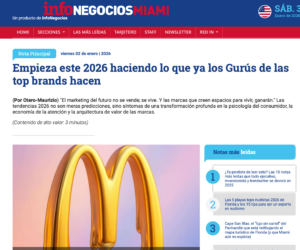Original article written by Brad Howarth, CMO
What an extreme honor it was to visit Melbourne and Sydney after all this time. Following my presentation at the Salesforce Retail and Consumer Goods Industries Summit, I met with my new friend Brad Howarth of CMO Magazine. Over the course of one hour, we explored everything from the future of brands, the new role of marketing in 2030 organizations, and of course, the rising world of Web3 (Web 3.0), the next iteration of the web.
Brian Solis: Why Web 3.0 will rewrite the concept of marketing
What if everything you knew about marketing stopped working? A conversation with Salesforce’s Brian Solis
Marketing practices have changed dramatically in recent years as new technologies, channels and processes have rewritten rules of engagement and delivery. But at its core, many key concepts that underpin marketing – aggregating audiences, designing and delivering campaigns and driving conversion – remain essentially the same as they were when they were first refined in the 1950s and 1960s.
However, the world is changing rapidly, and is evolving towards what may be the next great revolution in digital technologies: Web 3.0. This promises to bring together concepts relating to identity, trust, decentralisation and immersive virtual environments.
While the true impact of Web 3.0 is impossible to predict at this time, its proponents speak of a decentralised world where control and ownership of data and digital assets resides with the individual, not the corporation. Should these prognostications translate into reality, they will have a profound impact on the relationship between organisations and their customers, redefining customers as community members or stakeholders, and eschewing campaigns in favour of ongoing relationships. This signals a tumultuous time ahead for marketers.
While this kind of fundamental change is hard to consider amidst the day-to-day stresses of running a marketing function, it is very much on the mind of Brian Solis, awarding-winning author and renowned digital anthropologist and futurist. In his current role as global innovation evangelist at Salesforce, Solis is tasked with exploring and interpreting the ramifications of digital transformation, innovation and disruption. And there are few bigger emerging disruptions than that threatened by Web 3.0.
What concerns Solis now is that many organisations – and especially those born before the digital revolution of the mid-1990s – are still coming to grips with what it means to be a digital enterprise. And even those born of the digital era are themselves still adapting to the social nature of the web’s second iteration from the mid-2000s.
“The promise of Web 3.0 is very powerful, and it is also inevitable,” Solis tells CMO. “The difference between Web 2.0 and Web 3.0 is increasing the chasm between what businesses need to do for this digital-first era, and what they still doing from the pre-digital era.”
He says this is reflected in the way consumers experience ecommerce – a development of the Web’s first era– which is fundamentally the same today as it was 20 years ago.
“If you look at the digitisation we are doing, whether that is retail or business in general, it is digitising siloed models, to do what they do at scale with greater efficiency and intelligence,” Solis says. “But it is now firing over to a group of customers for whom it is not as effective as it used to be.
“That says the time for change is really here, because customers are not going to go backwards.”
Exploring new models
Should the promises of Web 3.0 hold true, Solis believes it will drive new forms of engagement between organisations and customers built around concepts of participation and value exchange, rather than mono-directional commerce.
“That trajectory is going to create a new level or standard of customer experience,” Solis says. “In this metaverse world, customers are going to have a much more immersive web. The Web 3.0 construct essentially promotes not just membership, but community.”
The greatest challenge Solis believes many executives will face will not be that of technology, but what will arise from their own experiences. These could create mindsets and processes optimised for a world that soon may not exist.
“In order to accelerate meaningful business transformation and customer relevance you have to start at a leadership level, and at a level that really questions your own assumptions of how to do things,” Solis says.
The challenge that emerges is that leaders who believe they are on the right path to digitisation today are only playing catch up, having spent the past few years modernising old processes rather than designing new ones.
“We didn’t accelerate digital innovation, we accelerated digitisation,” Solis says. “We are digitising pre-pandemic processes, supported by pre-pandemic organisational models. And many of these models are rooted in the 1950s and 1960s. We haven’t stopped to ask what else we can do.”
Innovator or fast follower
The challenge of Web 3.0 is reflected in the fact that for each generation of technology, much of the wealth has been created by entirely new entrants – Amazon and eBay for the Web’s first iteration, Facebook and Google for its second. While there are exceptions (Apple was formed in 1976, but subsequently underwent a renaissance with Steve Jobs’ return in 1996), organisations born prior to each wave have only succeeded through being fast followers.
Of course, history need not repeat itself, and the new giants of the Web 3.0 era are yet to emerge. That means opportunities exist for any organisation to take a leading role – if they start now.
“The ‘digital-first’ model has to be reimagined, and Web 3.0 preparation has to start now,” Solis says. “You have companies that are going to continue to digitise existing models. But you have another group of companies that are asking different questions now.
“You have to get back to basics and look at the construct of how you are connecting with your customers, and just find some pilots to test.”
For Solis, there are two factors that run in any traditional organisation’s favour. Firstly, he counsels the Web 3.9 revolution will not happen overnight, so agile organisations will have the opportunity to learn and adapt. Secondly, those that have invested to develop a 360-degree view of their customers, and organised their operations to utilise this perspective, will find their investments will be incredibly valuable in the Web 3.0 era.
“If you can know your customers, you can know what they value and how that value evolves over time, and how to organise around the delivery of that value now and over time,” Solis says. “It creates an agile, evolved model, so as the customer starts to taste the empowerment of what full Web 3.0 allows.
“What we are talking about is shift from being a consumer to being a stakeholder.”
Control-alt-delete
Ultimately, Solis believes the transformation to Web 3.0 and concepts such as the metaverse will represent a reset for marketers and for the organisations that employ them – something he describes as a ‘control-alt-delete’ moment.
“This is a control-alt-delete moment – one without a playbook – that requires the imagination and the reinvention of what it means to be a business in this new world,” Solis says. “If you had to invent the business of 2030 you wouldn’t look to the 1950s and 1960s to learn how to market to this audience – you would invent it. And that is the opportunity we all face.
“We’re not going to solve for it by trying to adapt yesterday’s models for 2035. It is a moment for leaders to control-alt-delete leadership itself.”

Brian Solis | Author, Keynote Speaker, Futurist
Brian Solis is world-renowned digital analyst, anthropologist and futurist. He is also a sought-after keynote speaker and an 8x best-selling author. In his new book, Lifescale: How to live a more creative, productive and happy life, Brian tackles the struggles of living in a world rife with constant digital distractions. His previous books, X: The Experience When Business Meets Design and What’s the Future of Business explore the future of customer and user experience design and modernizing customer engagement in the four moments of truth.
Invite him to speak at your next event or bring him in to your organization to inspire colleagues, executives and boards of directors.






Leave a Reply